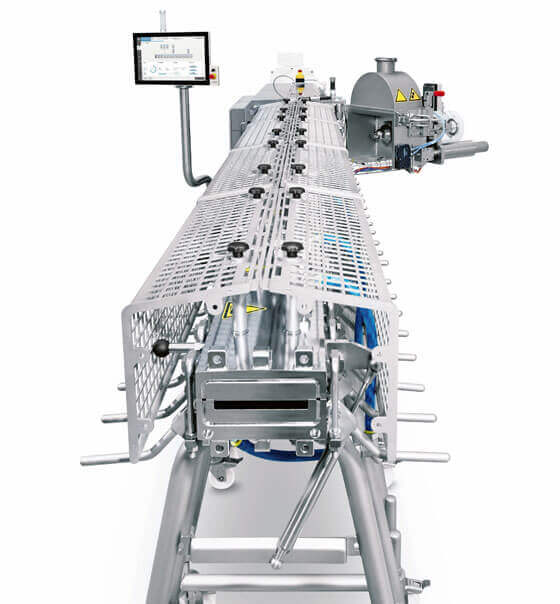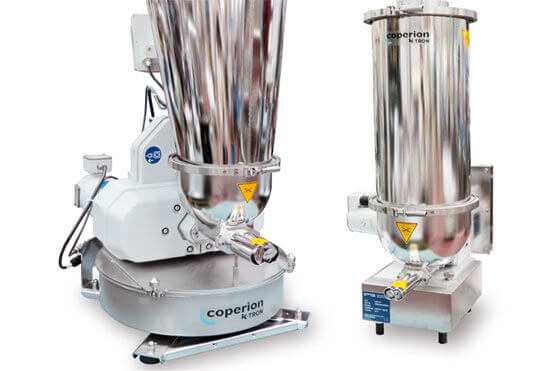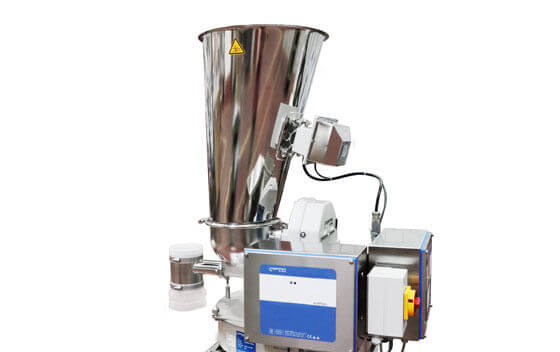For its food extrusion systems, Coperion offers a hybrid solution for manufacturing meat substitute products. With only a minimum of retrofitting effort, Texturized Vegetable Protein (TVP), High Moisture Meat Analogues (HMMA), and numerous other extrudates such as snacks and cereals can be manufactured on the same machine.

注册订阅科倍隆新闻通讯,查看我们最新动态
Coperion Food Extrusion System in Hybrid Design
Ideal for the Extrusion of TVP, HMMA and Much More.

Coperion’s food extrusion systems are used in the manufacture of both TVP and HMMA. Previously, the system’s configuration differed for each application. While the ZGF centric food pelletizer is attached to the process section for manufacturing TVP in order to cut the product directly at the nozzle plate, HMMA is discharged using a specialized cooling die which produces a product strand exhibiting a texture closely resembling that of genuine meat. The feeding section and the extruder’s process section remain largely unchanged for both applications.
Using Coperion’s adapter solution, the ZSK Food Extruder’s discharge can be changed over from a ZGF to a cooling die in record time. The machine’s operating personnel can easily perform the changeover; no electrician is needed. The ZGF is first opened and moved to the side. Next, after the nozzle plate is opened by loosening a few screws, the nozzle is switched using the adapter, and the cooling die is attached. The same principle functions just as quickly in reverse when performing product changeovers from an HMMA process to TVP.
Extrusion of Plant Protein Products – TVP and HMMA Processes Defined
TVP is used as a meat analogue, vegan meat or ingredient and as a supplement to meat products. It can be produced in various sizes and forms, as smaller pellets or larger chunks, broken down or ground. TVP is a dry, expanded product with a long shelf life under normal ambient conditions. TVP requires rehydration in water/liquid before use.
When manufacturing TVP, the extruder’s main inlet is continually fed with bulk raw protein material using Coperion K-Tron’s high accuracy loss-in-weight feeders and material handling refill systems. Immediately thereafter, water is injected using Coperion K-Tron liquid feeders. In certain cases, direct steam injection is applied into the process section as well. Within the process section, materials are mixed, kneaded and cooked. The product then moves out of the extruder via a nozzle plate where it is processed such that it achieves a porous structure with oriented fibers or layers. The attached Coperion ZGF pelletizer’s knife rotor then immediately cuts the product. The TVP granules are then dried to ensure long-term product stability.
Alternatively, HMMA is primarily used as a high-quality meat-analogue product in ready-to-eat meals. By adjusting recipe and process parameters, the structures of different meat types can be replicated with striking similarity to the original. HMMA’s moisture content lies between approximately 50-80%, therefore requiring refrigeration. Protein sources used to manufacture high-quality HMMA are primarily legumes such as soy, lupine or pea, or novel sources such as algae. In certain cases, for example when manufacturing meat product extenders, lesser quantities of genuine meat or fish products are added.
For the HMMA process, the bulk raw protein material is fed into the extruder inlet, to which water is then added. Within the ZSK Food Extruder a thermomechanical process takes place. The mass is fully mixed, kneaded and cooked in the extruder’s process section. Discharge takes place using a specialized cooling die that generates a meat-like texture which is “frozen in”. The result is a solid strand with fiber structure similar to flesh; the strand is then conveyed to the next process step.

The Coperion K-Tron Twin Screw Feeder – Ideal for Accurate Feeding of Ingredients Direct to the Extruder
When designing a continuous extrusion line, accurate delivery of the individual ingredients to the extrusion process is critical to create stability and maximize end product quality. For this reason, highly accurate gravimetric feeders are the feed method of choice, since they measure the weight of the material being fed and adjust feeder output to maintain the desired setpoint. Conversely, volumetric feeders do not weigh the flow; they operate by delivering a certain volume of material per unit time from which a weight-based flow rate is inferred by the process of calibration.
The most popular type of gravimetric feeder used in continuous processes is the loss-in-weight (LIW) feeder. A LIW feeder consists of a hopper and feeder that are isolated from the process via flexible connections so the entire system can be continuously weighed.

LIW feeders are typically either mounted on weigh scales or suspended on load cells. The Coperion K-Tron load cell is a highly accurate instrument, designed specifically for the rate and accuracy requirements of dynamic feeding, and features a resolution as high as 1:8,000,000 in 20 ms. As the feeder discharges material, system weight decreases. The speed of the metering device is controlled to result in a per-unit-time loss of system weight equal to the desired feed rate.
At any stage of the production process undetected feed rate and proportioning errors waste ingredients and add to overall ingredient costs. For example, within the very sensitive high-moisture extrusion process, feeding inaccuracy can easily cause shut-downs of the line, so that the extruder and special die head which creates the fibrous material characteristics need to be cleaned and restarted.
Since many of the food ingredients used in food processing can be poorly flowing and cohesive, Coperion K-Tron provides a variety of options in screw configurations, overall feeder designs and also innovative devices such as the ActiFlowTM bulk solids activator. The ActiFlow is a smart flow aid device which operates in conjunction with the LIW feeder controller and its load cells.

ZSK Food Extruder in Hybrid Design for Maximum Flexibility
The Coperion Hybrid Design ZSK Extruder allows the manufacture both TVP and HMMA on the same machine with only a minimum of retrofitting. The feeding and process section for both applications are nearly identical, while the discharge units differ significantly. While the aforementioned ZGF Centric Pelletizer is attached to the process section for manufacturing TVP in order to cut the product directly at the nozzle plate, HMMA is discharged using a long specialized cooling nozzle which produces a product strand that exhibits a texture closely resembling that of genuine meat. Using Coperion’s adapter solution, the ZSK Extruder’s discharge can be switched from a pelletizer to a cooling nozzle in no time. The same principle functions just as quickly in reverse when switching from an HMMA process to TVP.
In addition, the extruder twin screws’ combination of self-cleaning action and modular construction allow the processing of numerous other products on the ZSK system such as snacks and cereals.
Stefan Gebhardt, General Manager of Business Unit Food & Pharma at Coperion, is convinced the ZSK Food Extruder hybrid design will offer significant benefits: “The high demand for this hybrid technology shows us that it corresponds exactly to the current market trend. The need for meat substitute products is growing steadily while at the same time undergoing major changes. With this hybrid machine concept that allows production of TVP and HMMA on one and the same extruder, we’re providing meat analogue manufacturers with a solution that gives them a high degree of flexibility to be optimally prepared for rapidly changing market conditions.”
Your Contact
-
Stefan Gebhardt
- email: stefan.gebhardt@coperion.com
- telephone: +49 (0)711 897 3048